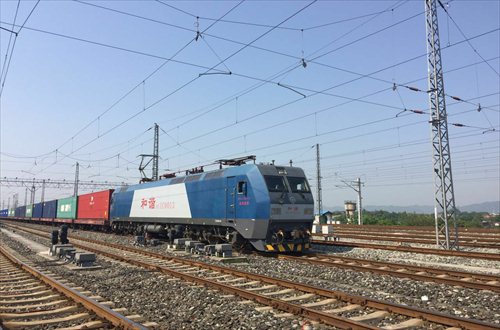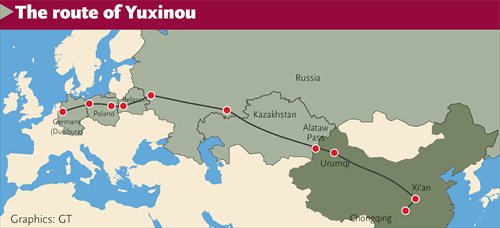Faster than shipping, cheaper than air freight, railway illustrates benefits of B&R initiative
The Chongqing-Xinjiang-Europe International Railway traverses Europe, Central Asia, Russia and China. It is an example of the benefits of China's "One Belt and One Road" (B&R) initiative. The railway represents a new form of cargo trade that officials said is a viable option for the modern supply chain, which is characterized by smaller orders, multiple dispatches and high delivery frequencies. Despite the attention the railway has received in China, European companies have yet to take full advantage of the railway, which currently carries more goods from east to west than west to east.

A train carrying 80 twenty-foot equivalent units leaves a train depot in a suburb of Southwest China's Chongqing Municipality on Thursday. The cargo will arrive at Duisburg, Germany two weeks later. Photo: Chu Daye/GT

Graphics: GT
At 10 am on Thursday, after two blasts of a deafening train whistle, a freight train carrying 80 twenty-foot equivalent units (TEU) set off from a train depot in a suburb of Southwest China's Chongqing Municipality. In about two weeks, it will arrive at its destination - Duisburg, Germany.
"The train will travel at 120 kilometers per hour, the top speed for cargo trains [in China]," the train's operator told the Global Times shortly before departure.
The train will traverse a meandering track through China for about two days before exiting the country at the Alataw Pass in Northwest China's Xinjiang Uyghur Autonomous Region. It will then pass through Kazakhstan, Russia, Belarus and Poland before reaching its ultimate destination in Germany.
At the Alataw Pass, the containers will be loaded onto trains from Kazakhstan to cope with the wide gauge in the country. The locomotive and trailers will stay in China.
This railway, one of many Sino-European rail links, is known as the Chongqing-Xinjiang-Europe International Railway, or Yuxinou. The route is the first among all such rail links and it currently handles about 80 percent of total cargo volumes from China.
In the first four months of 2016, 83 trains carrying 6,948 TEUs in goods worth $549 million left Chongqing for Europe, data from the Chongqing Customs District showed.
Chongqing, China's only inland municipality, is the fastest growing locality on the mainland. In 2015, its GDP grew by 11 percent, 4.1 percentage points higher than the national average.
The city has become China's largest automobile producer, according to media reports. It also manufactures about 40 percent of the world's laptops and 30 percent of China's motorcycles.
The Yuxinou links Europe, Central Asia, Russia and China. It is a tangible, beneficial example of China's "One Belt and One Road" (B&R) initiative, experts said.
Formally called the Silk Road Economic Belt and the 21st Century Maritime Silk Road, the B&R initiative was proposed in 2013.
The railway is an effective channel of inter-region economic and trade cooperation and has the potential to help the European economy recover, experts noted.
With coordination of countries along the route, Yuxinou trains spend 14 days on average to transport goods 11,179 kilometers from China to Europe. It takes about one-third the time to transport goods by seas, and costs one-fifth the price of sending goods by air, according to media reports.
Companies have used the railway to transport goods of dozens of categories, including electronics and machinery, according to the Chongqing Customs District.
On the way back, the trains carry goods such as auto parts, sedans and baby products.
In 2015, China was the EU's second largest trading partner, after the US.
Growing opportunities
Due to the supply glut in the global shipping industry, shipping companies have actually slowed down their ships to cut costs, with many ships spending two months at the sea. More time at sea means companies will have to maintain larger inventories, which freezes up more of their assets and shortens the shelf life of their goods, said an official at the Chongqing Foreign Trade and Economic Relations Commission (COFTEC), noting that this change, plus a recovering EU economy, are good news for the Yuxinou's development.
Furthermore, the new form of cargo transport heralded by Yuxinou is a viable option for the modern supply chain, which is characterized by smaller orders, multiple dispatches and high delivery frequencies, said the COFTEC official, who declined to be named.
"Information technology has changed the way modern manufacturing and trade work. Orders are now placed with shorter notice and more stringent requirements for storage and supply chain management," the official told the Global Times on Wednesday.
With Chongqing's role as a key logistics center in Southwest and West China, COFTEC is working on expanding cargo demand and optimizing logistics for customers in East China and South China, as well as Southeast Asia.
In June 2015, about 1,000 tons of coffee beans were shipped from Vietnam to Shanghai, and then to Chongqing. The beans were processed in plants in Chongqing and finally sold to Europe, transported via the Yuxinou, according to Qi Dan, general manager of Yuxinou (Chongqing) Logistics Co. The company handles logistics for the freight rail route.
The example of the coffee beans, which were shipped by sea, river, road and rail, demonstrates the logistics flow of three national initiatives that the central government is promoting: the 21st Century Maritime Silk Road, the Silk Road Economic Belt and the Yangtze River economic belt.
"Coffee, as a commodity, is almost as valuable as gold. The demand for coffee is also rigid," Qi said, adding that the city is building itself to become a future trading center for the commodity.
Selling the railway to Europe
Currently, five to six trains go to Europe on average each week, but only two trains come back, according to the Chongqing Customs District.
To help balance the trade, European media could put more effort into promoting the rail link, experts said.
Reality has shown that rail lines like the Yuxinou can ensure that goods move freely, and have relatively good economic value, the COFTEC official said.
European companies could take a more active role in utilizing the route and diversifying their existing logistics chains, which are currently composed primarily of shipping and air freight.
Many companies in Europe have yet to take advantage of this new, intercontinental trade conduit, and use it as a compliment to existing trade routes. "It requires reworking their supply chain system, and it takes time," the official said.
"Some big European companies, such as Daimler AG and BMW, have already given the new trade route a try, but others, including Europe's invaluable army of small and medium-sized enterprises, are still watching," the official said.
"It is time to stop watching and start trying the new option," the official said.
Qi said his company has yet to turn a profit.
"If the railway operators can lower freight costs a bit, and goods from China see their value increase a bit, then we as a company can see a profit. In fact, the cost has already come down following negotiations to optimize the trade route," Qi said.
Qi noted that the direct and indirect socioeconomic benefits of the Yuxinou cannot be gauged by one company's earning statement.
"Look at the increasing media coverage of Chongqing and the flocks of business delegations visiting the city. Yuxinou has become the city's gold-plated business card. Businessmen come to Chongqing looking for opportunities, knowing that the city is the starting point of a trade route across Eurasia with the potential to serve billions of people," he said.
Newspaper headline: Laying tracks for trade